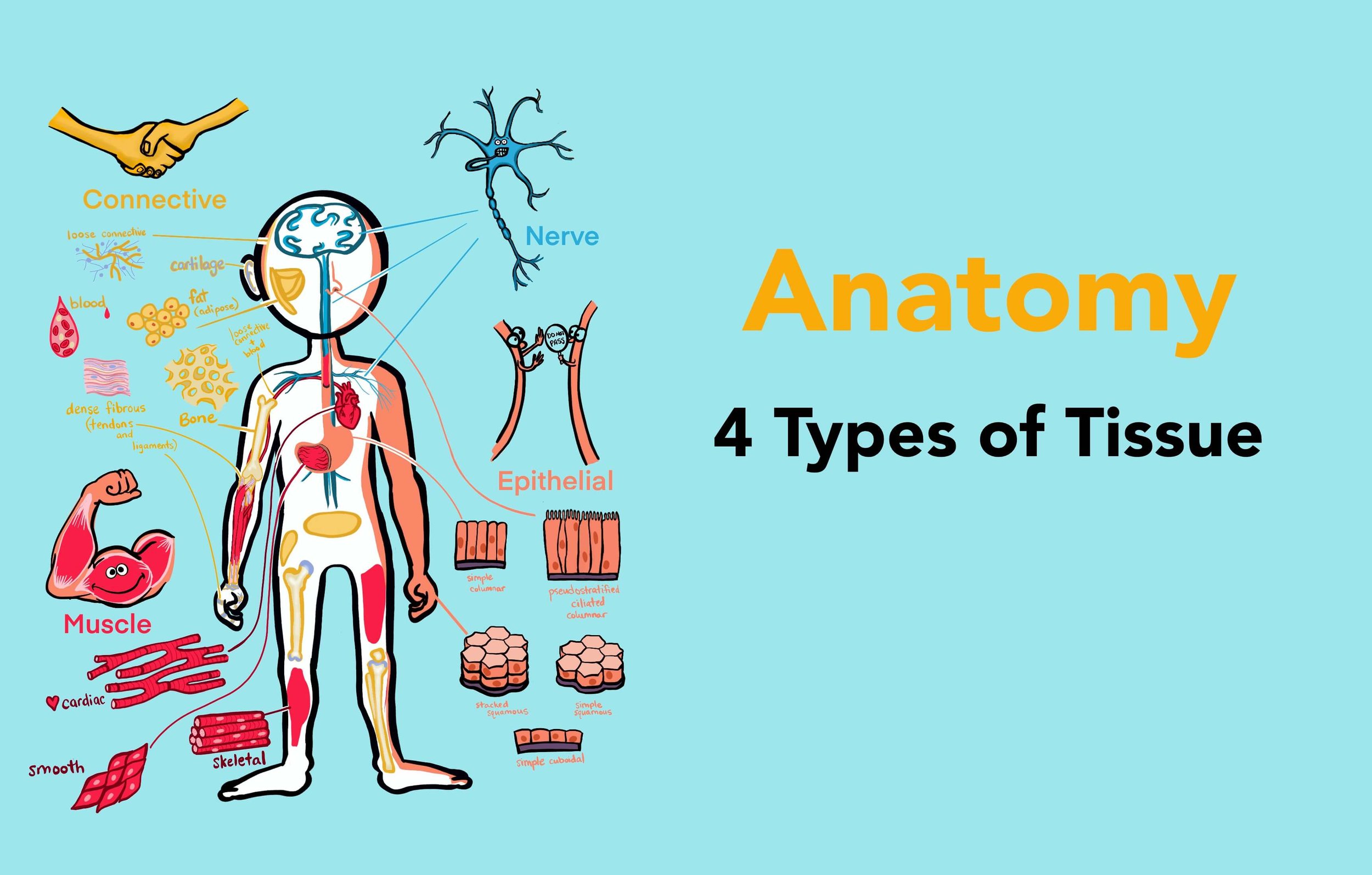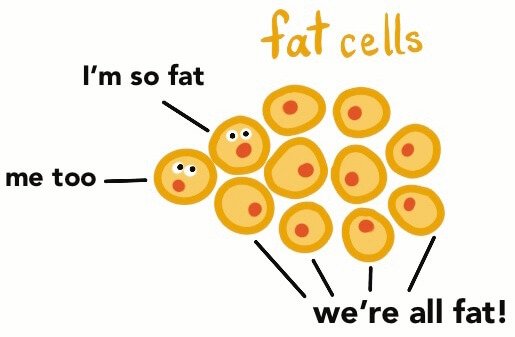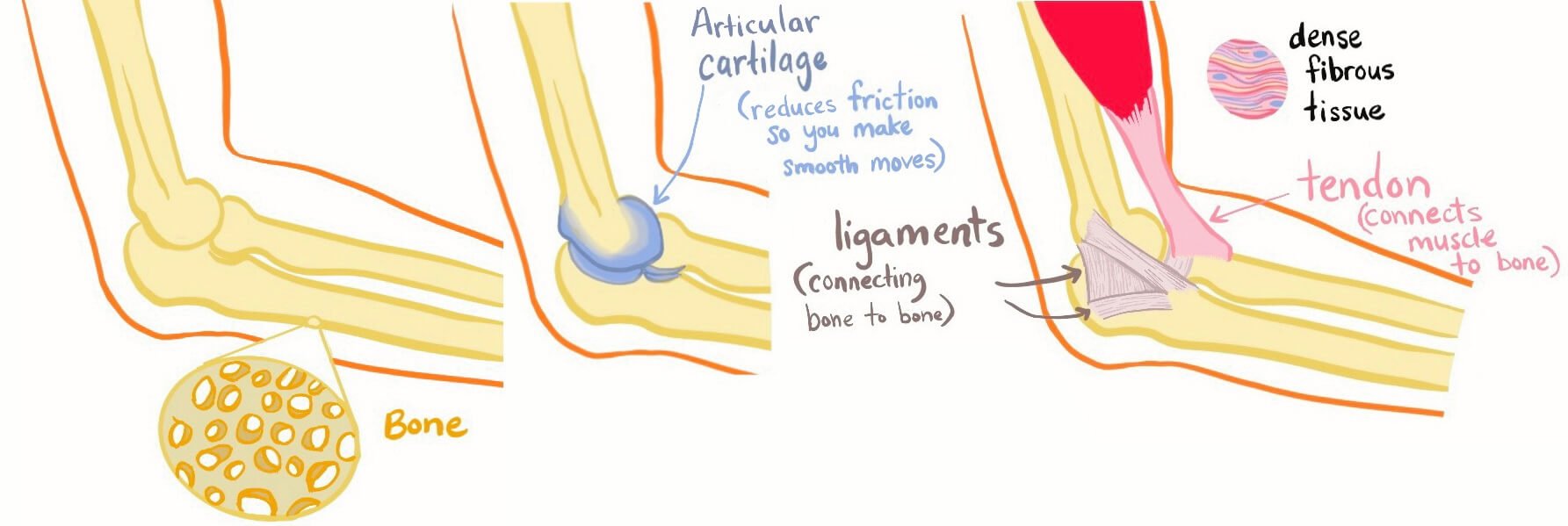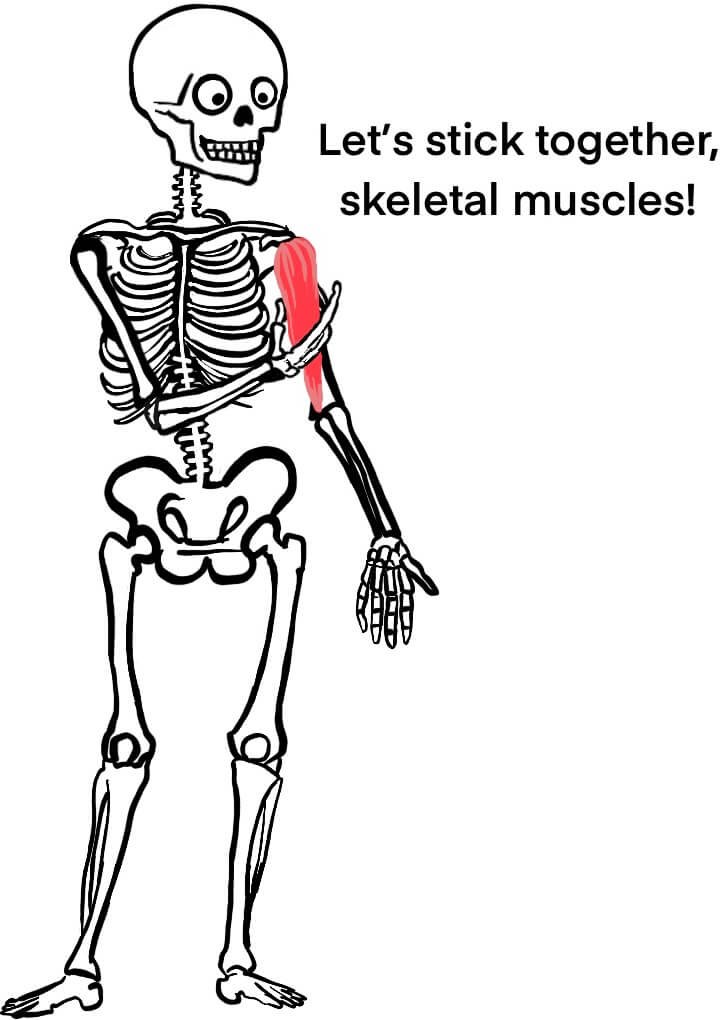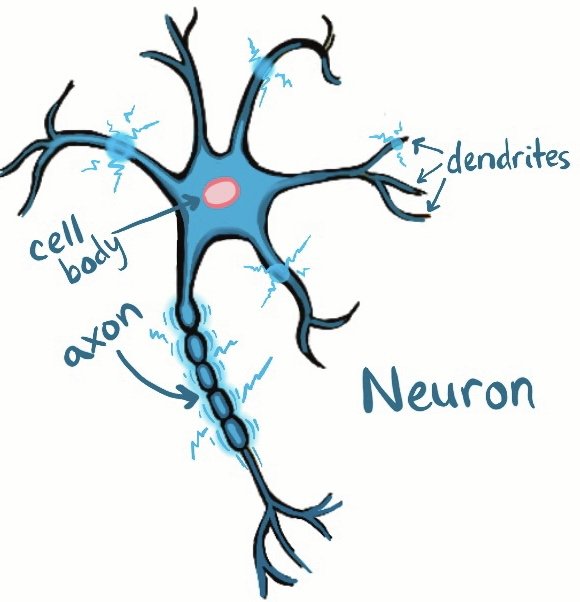Discover the four types of tissues that form our entire body in this fun anatomy lesson for kids.
Tissues are the Kleenex of your body where you can keep your boogers… … well, not exactly. But you can think of body tissue like the fabric of the body. Some of these tissues are hard (like bone), others squishy (like fat), and others like liquid (like blood). There are four types of tissues, and each does different things. The four types of tissues are connective, epithelial, muscle, and nerve.
Connective tissues support.
Epithelial tissues cover and protect.
Muscles enable movement, and
Nerve tissue controls and communicates.
CONNECTIVE
Connective tissues connect and provide support. Connective tissues are the most diverse tissue in your body, and it is found pretty much everywhere. Connective tissues help hold your organs together. Connective tissue, like blood, flows through your heart and delivers things throughout your body. Connective tissues like bones help you stand upright and provide structure for you to move. Connective tissues even insulate you from the cold and hold your skin together. Connective tissues include blood, bones, cartilage, fat, dense fibrous tissue, and loose connective tissue.
Fat
We sometimes think of fat as bad, and that is true if our body has too much of it. However, fat is essential for your body. Body fat, also called adipose, is used for storing energy and insulation. You would get cold very fast if you didn’t have fat cells. It also provides padding and cushions shocks so when you sit on your bottom it’s nice and comfy! You also use fat to power your muscles and cells throughout your body. More than half of your brain is made of fat! Fat helps provide structure and fluidity to its cells.
Bone, Cartilage, and Dense Fibrous
Connective tissues like bones and cartilage support and shape the body. Bone gives structure to your whole body and protects vital organs like your brain, heart, and lungs.
Dense fibrous tissues like ligaments and tendons bind these bones together and attach them to muscles for movement. Ligaments connect bone to other bone, and tendons connect bone to muscle.
Cartilage found in joints like elbows, shoulders, and knees is called articular cartilage, and it allows touching bones to move easier. Articular cartilage is like smooth padding that reduces friction between bones. (Friction is when things rub together, creating tension and heat.) Cartilage is also found in your nose and ears, giving structure that can also bend. You can fold your ears and wiggle your nose because they are made of cartilage, which gives them a more pliable structure than bone. Ever heard the song “Do Your Ears Hang Low?” Without cartilage, your ears would hang low.
Blood
Blood is connective tissue that connects all systems of the body. For example, blood connects the digestive system to the other cells of the body, delivering food to cells. Blood also transports nutrients, oxygen, and waste.
I think of blood as a liquid, so it sounds weird to call it a tissue. However, blood has a matrix that ties all the cells together. The fluid part of blood, plasma, is its matrix, which ties the red and white blood cells together in one “tissue.”
Loose Connective Tissue
Loose connective tissue surrounds blood vessels and nerves, and helps hold organs together, including the skin. At the bottom of epithelial skin cells is a layer of tissue keeping those cells held together called the basement membrane, which is a type of loose connective tissue. Loose connective tissues can be found all over the body.
EPITHELIAL
Epithelial tissue organizes and orders the body parts and systems. This tissue covers and protects, keeping things separate. It is also used for absorption, sensation, and secretion.
One example of epithelial tissue is our skin, and it covers and protects the entire body! Epithelial tissue forms boundaries, like separating each organ from one another, so the stomach acid doesn’t leak into your lungs. Some epithelial tissue won’t allow anything through it, and others will allow certain things to pass through or come out.
For example, our skin doesn’t allow our blood or organs to come out of our body, but it does allow sweat. And we even absorb things through our skin, but only small amounts, which is why you can’t feed your body by rolling in a pile of cheeseburgers.
There are several types of epithelial cells. They are named after their shapes: column, cuboidal cells that look like cubs, and squamous or scale-like. These cells can be simple in a single layer, or stacked in multiple layers. For example, stacked squamous cells provide a thicker barrier.
These different cells can be found in all sorts of different places in your body, protecting and deciding what is allowed to pass through it. For example, our small intestines further digest the food they receive from the stomach, and that food travels inside the small intestine. But the epithelial cells that line the small intestine also absorb and secrete, pushing nutrients out from its intestinal walls, delivering fats, sugars, and proteins to the bloodstream to be transported throughout the body.
MUSCLE
Muscle tissue has three kinds: skeletal, cardiac, and smooth. Muscles make things move. Muscles can make your bones move, or move your stomach to mix your food with gastric juices, or even pump the blood in your heart.
Skeletal
When I think of muscles, I usually think of skeletal muscles. These are the muscles we use to pick up things, go for a run, and show off our biceps. Your legs and arms have skeletal muscles. Skeletal muscles are voluntary, meaning you can decide when to move them.
It sounds funny to call these muscles skeletal because the skeleton is our bones. Though these muscles aren’t part of the skeleton, skeletal muscles are attached to the skeleton. Without bones, our muscles would be a big glob on the ground. The skeleton provides support for you to stand upright, and the skeletal muscles make those bones move!
Cardiac
Cardiac muscles are only found in your heart and have a unique branching shape. These muscles pump the blood in and out of your heart. Cardiac and smooth muscles are involuntary, meaning they move all on their own, even when you aren’t thinking about it. You wouldn’t want to think, “Now I need to make my heart beat” every moment of your life, would you? It’s very nice to have these muscles working without thinking about it.
Smooth
Smooth muscles are found in organs like your stomach. They move things around, like food and digestive juices. And again, you don’t even need to think about it!
NERVE
When we say we “get nervous,” or that someone is “getting on our nerves,” we are comparing our life experiences to our nerves ability to feel things like pain or irritation. Our nervous system is made up of nerve tissue that controls and communicates with our whole body.
The boss of the nervous system is the brain. The brain communicates to the rest of your body through the spine and peripheral nervous system. The central nervous system is the brain and spinal cord, and the peripheral nervous system is everything else. Nerves are kind of like electrical wires. Electrical signals travel along the nerves to send messages to and from the brain. With these messages the nervous system controls our movements and reactions. It also enables us to feel pain, warmth, hugs, and more.
You might think of nerves like telephone lines of the body. Your peripheral nerves receive messages and these messages travel along neurons through the spine and to the brain. The brain says “Ah, hello, I got the message!” In the same way the brain also sends messages back to our arms, legs, and other body parts.
There are two types of nerve tissues— neurons and neuroglia.
Neurons
Neurons have three parts—cell body, dendrites, and axon. The cell body has the nucleus, houses the cell’s DNA, and makes proteins for the rest of the cell. Dendrites look like branches and function like little feelers ready to receive input. The axon is the output portion of the neuron. If the neuron wants to communicate with another neuron, it sends an electrical signal throughout the entire axon.
Neurologlia
Neuroglia, also called glial cells, support, protect and defend neurons. They are neurons’ little helper buddies.
Your body’s tissues can be very complex and do many amazing things. Like a master designer, God wove cells together to form these remarkable tissues, which cooperate to form organs and whole systems within the body. Perhaps that is why the Bible says, “You formed my inward parts; you knitted me together in my mother’s womb. I praise you, for I am fearfully and wonderfully made.” Psalm 139:13-14a.

